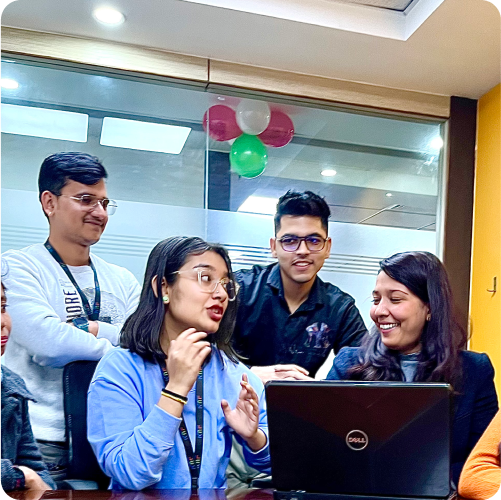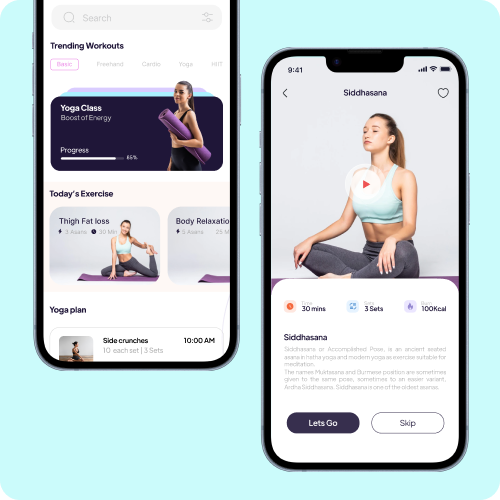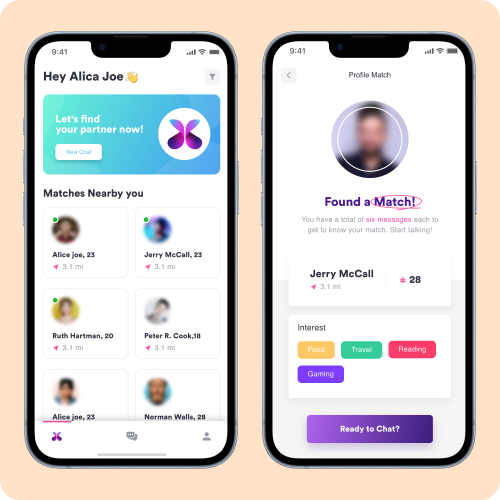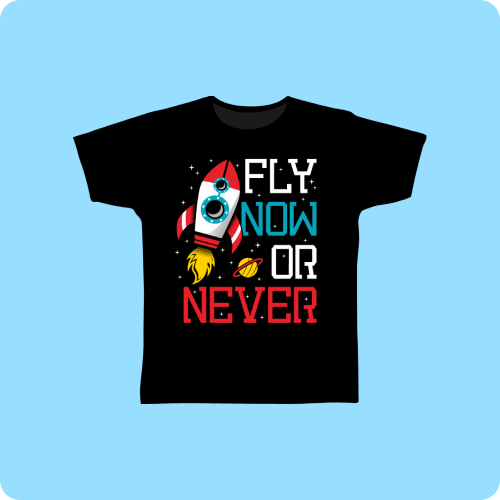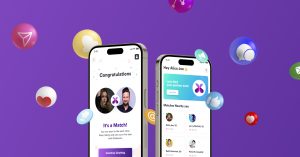Social media is the door to the virtual world and social media app development requires more than just asking how to make a social media app. It wouldn’t be wrong to mention that social media is a new addiction in this digital era – people just can’t get enough of it!
If you see the recent numbers, in 2024, on average, a person managed around 8.4 social media accounts, namely Facebook and Instagram, Twitter, TikTok, YouTube, and so on. These platforms aren’t just for fun anymore – they’re shaping our media, culture, education, politics, and business.
With an increasing number of people spending time on social media, app owners are capitalizing on this trend and making a significant income through strategic app monetization methods. So, if you’re considering being a part of the massive success of social media, you might be thinking about creating your very own social media app.
If you’re intrigued by the idea but unsure where to start, you’ve landed in the right spot. This guide is your go-to for understanding the ins and outs of social media app development. It’s not just about the how-to; it’s also about figuring out if building a social media platform is the right move for you. Let’s dive into the details.
Why Should You Go for Social Media App Development in 2024?
Considering a social media app for your business in 2024 is more than just a trend; it’s a strategic move with substantial benefits.
Firstly, having your own social media app means you can interact directly with customers and understand their perspective, problem. This will help you to give them a personalized solution. It’s like having a special place where you control what people see about your brand. This helps in creating a community, talking directly to customers, and making them stick around.
Next up, having a social media app is like supercharging your marketing. You get a great space to showcase your products, share news, and run special deals. This means more people get to know about your brand, and you can get new customers too.
Besides, your app gives you insights into what your customers like. This info is like a guide, helping you improve your products or services to make customers even happier.
And let’s not forget about making money. You can have features in your app, like special purchases, cool content, or ads, which can bring in some extra income. Plus, being on your customers’ phones through the app means they’re more likely to remember and choose your brand.
In a nutshell, going for social media app development in 2023 gives you a cool way to talk to customers, boosts your marketing, helps you understand your customers better, and opens up ways to make money. It’s not just staying current in the digital world; it’s building a strong and lasting connection with your customers.
Social Media Apps Market in 2024
In 2024, the social media app market continues to witness exponential growth, with staggering statistics highlighting its pervasive influence. Research indicates that the average individual manages approximately 8.4 social media accounts.

Thus, showcasing the widespread adoption and reliance on platforms such as Facebook, Instagram, Twitter, TikTok, and YouTube. This proliferation underscores the integral role social media plays in shaping modern communication, culture, and commerce.
Furthermore, the market is characterized by diverse user demographics and preferences, with niche platforms catering to specific interests gaining traction. For instance, discussion forums like Quora and Reddit provide virtual town hall experiences, while content-sharing networks such as Pinterest and Flipboard offer inspiration and curation tools.
Understanding the social media apps market in 2024 is paramount for those exploring how to make a social media app. With a projected global revenue of $219.8bn in 2024 in the social media advertising segment alone, the market presents lucrative opportunities for app developers.
Additionally, the industry is witnessing a shift towards personalized experiences, with 76% of consumers expressing a preference for brands that understand and cater to their needs.
By leveraging these insights and capitalizing on emerging trends, app creators can position themselves for success in the dynamic and competitive social media app market of 2024.
Types of Social Media Apps
Understanding the various types of social media apps is essential for anyone embarking on the journey of how to make a social media app. In 2024, the social media landscape is diverse, catering to a wide range of user interests, preferences, and communication styles. By categorizing social media apps into distinct types, developers can gain valuable insights into user behavior, market trends, and potential opportunities for innovation.
1. Social Networks
Social networks serve as digital hangout spots where users connect with friends, family, and like-minded individuals to share updates, photos, videos, and thoughts. Platforms like Facebook exemplify this category, providing users with tools to create profiles, join groups, and engage in discussions.
2. Media Sharing Networks
Media sharing networks focus on the dissemination of multimedia content, including photos, videos, and live streams. Instagram and TikTok are prominent examples, offering users the ability to showcase their creativity, follow influencers, and explore trending content.
3. Discussion Forums
Discussion forums provide users with virtual spaces to initiate and participate in discussions on various topics. Platforms like Quora and Reddit facilitate knowledge-sharing, Q&A sessions, and community interactions, fostering a sense of camaraderie among users with shared interests.
4. Content Sharing Networks
Content sharing networks enable users to discover, save, and share articles, blog posts, images, and videos from across the web. Pinterest and Flipboard excel in this category, offering users curated collections of content tailored to their interests and preferences.
5. Blogging and Publishing Networks
Blogging and publishing networks empower users to create and share long-form content, including articles, essays, and opinion pieces. Platforms like Medium and Twitter provide users with tools to express themselves, connect with readers, and build online communities around their ideas.
6. Relationship Networks
Relationship networks, also known as dating apps, facilitate connections between individuals seeking romantic or platonic relationships. Tinder and Badoo are prominent examples, offering users features such as swiping, messaging, and profile customization to facilitate meaningful connections.
7. Interest-Based Networks
Interest-based networks bring together individuals with shared passions, hobbies, and professional interests. LinkedIn, for instance, serves as a networking platform for professionals, enabling users to connect with colleagues, explore job opportunities, and share industry insights.
8. Anonymous Social Networks
Anonymous social networks provide users with the ability to share content and engage in conversations without revealing their identities. Platforms like Whisper and Ask.fm offer users a sense of privacy and anonymity, encouraging candid discussions and expressions of thoughts and feelings.
By understanding the nuances of each type of social media app, developers can tailor their strategies, features, and user experiences to meet the specific needs and preferences of their target audience. Whether creating a niche platform for content sharing or a comprehensive social network for community engagement, knowledge of the diverse landscape of social media apps is essential for success in the competitive market of 2024.
Read more – How much does Custom Software Development Cost?
Must-Have Features For Your Social Media App
When considering how to make a social media app, incorporating must-have features is crucial to ensure user engagement, retention, and overall success. These features serve as the foundation of the app, providing essential functionalities that users expect and appreciate. Here are key must-have features for your social media app:
Sign In & Tutorial
Implement various sign-in options such as email & password, social media account integration (e.g., Facebook, Google), or phone registration to cater to user preferences. Additionally, provide a comprehensive tutorial or onboarding process to guide new users through the app’s functionalities, ensuring a seamless experience from the start.
User Profile
Enable users to create personalized profiles that reflect their identity, interests, and preferences. Allow users to customize their profiles with profile pictures, cover photos, bio descriptions, and other relevant information. Profiles serve as a means for users to express themselves and connect with others within the app’s community.
Content Feed
Develop a dynamic content feed algorithm that curates relevant and engaging content based on users’ interests, interactions, and connections. Ensure that the content feed is visually appealing, easy to navigate, and constantly updated to keep users entertained and informed.
Search
Implement a robust search functionality that allows users to discover specific content, users, groups, or topics within the app. Enable users to search by keywords, hashtags, or filters to find relevant content and connections quickly. A user-friendly search feature enhances the app’s usability and facilitates content discovery.
Chat
Integrate a messaging feature that enables users to communicate with each other privately or in group chats. Support various communication formats such as text messages, voice messages, photos, videos, and stickers to cater to diverse user preferences. A seamless and reliable chat feature fosters connections and interactions among users, enhancing the overall social experience.
Content Creator
Provide users with intuitive tools and features to create and share content within the app. Support multiple content formats such as text posts, images, videos, stories, and live streams. Additionally, offer editing tools, filters, and effects to enhance the quality and creativity of user-generated content. Empowering users to express themselves through content creation promotes user engagement and community building.
Push Notifications
Implement push notifications to keep users informed about new messages, likes, comments, friend requests, and other relevant activities within the app. Personalize notifications based on users’ preferences and behaviors to ensure timely and relevant updates. Push notifications help drive user engagement and retention by keeping users actively engaged with the app.
Third-Party Social Network Integration
Enable seamless integration with popular third-party social networks such as Facebook, Twitter, and Instagram to facilitate content sharing and cross-platform connectivity. Allow users to share content from your app to other social media platforms and vice versa, expanding the app’s reach and user base. Third-party integration enhances user convenience and connectivity, making it easier for users to engage with the app and share content with their existing social networks.
Bonus Feature: Augmented Reality (AR) Integration
Integrate AR technology to offer immersive experiences, allowing users to overlay virtual content in the real world. Users can create AR-enhanced photos and videos with virtual objects, effects, and filters, enhancing engagement and creativity. AR features can also enable virtual try-on experiences for products and interactive games, setting your app apart with futuristic experiences.
By incorporating these must-have features into your social media app, you can create a compelling and user-friendly platform that attracts and retains users. Prioritize functionality, usability, and user experience to ensure the success of your app in the competitive social media landscape.
Don’t miss out – How to Build Apps Similar to Snapchat?
How Much Does it Cost to Create a Social Media App?
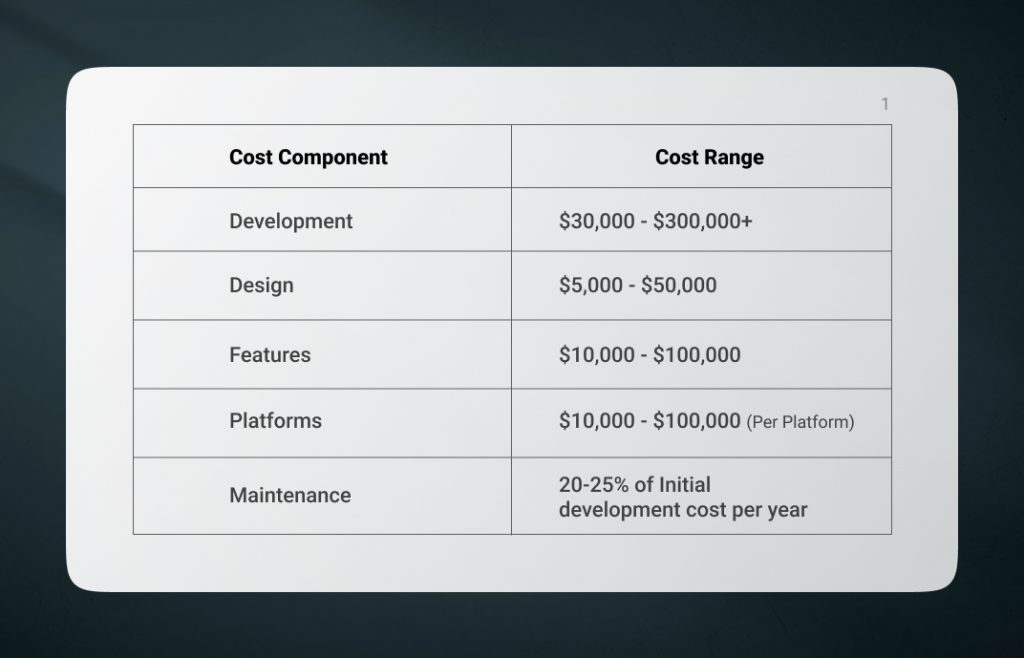
Certainly, here’s a breakdown of the numerical cost range included in each cost component for creating a social media app:
- Development: The cost of development can vary significantly depending on the complexity of the app and the hourly rates of developers. Generally, hiring developers to build the infrastructure, features, and functionality of a social media app can range from $30,000 to $300,000 or more.
- Design: Design costs typically range from $5,000 to $50,000, depending on the level of customization, the intricacy of the UI/UX, and the expertise of the designers involved.
- Features: Implementing essential features such as user authentication, profiles, feeds, messaging, and content creation can cost between $10,000 to $100,000, depending on the complexity and number of features.
- Platforms: Developing for multiple platforms like iOS, Android, and web can increase costs due to compatibility and optimization requirements. Costs for platform development can range from $10,000 to $100,000 or more per platform, depending on the extent of customization and integration needed.
- Maintenance: Ongoing maintenance costs typically amount to about 20-25% of the initial development cost per year. For a social media app with development costs ranging from $50,000 to $500,000, maintenance costs could range from $10,000 to $125,000 per year.
These cost ranges are estimates and can vary based on various factors such as project complexity, geographic location of the development team, and specific requirements of the social media app. It’s essential to consult with experienced developers and thoroughly analyze your app’s needs to get an accurate cost estimate.
How To Make A Social Media App The Right Way?
Step 1: Choosing The Right Social Media Type
Before you jump into creating a social network app, you must know the different types of social media apps. These will be your secret weapon for checking out the competition and understanding what users want.
1. Social Networks:
These are like digital hangout spots where people connect and create communities. Think of Facebook – it’s not just for posting pics; it’s about joining groups with folks who share your interests.
2. Media Sharing Networks:
Places where you can share different content types. Instagram and TikTok are prime examples. Instagram is for pics, and TikTok is all about short videos.
3. Discussion Forums:
These are like virtual town halls. Users start discussions, ask questions, and get answers from the community. Quora and Reddit are big players here.
4. Content Sharing Networks:
Perfect for finding inspiration. Users save links to cool stuff, organize them, and share with others. Pinterest and Flipboard are kings in this arena.
5. Blogging and Publishing Networks:
No need to be a tech whiz to start a blog. Platforms like Medium and Twitter make sharing articles and thoughts a breeze.
6. Relationship Networks:
AKA dating apps. Tinder and Badoo help users meet new people and maybe find that special someone.
7. Interest-Based Networks:
Connect with folks who share your passions. LinkedIn, for example, brings professionals together.
8. Anonymous Social Networks:
Share content without giving away your identity. Whisper and Ask.fm keep things mysterious.
Understanding these types is like having a treasure map for your social media app journey.
Step 2: Finding Your Perfect Match – Product and Market Edition
So, here’s the deal: a product/market fit is like finding your app’s soulmate – it’s when startups create something that really clicks with their target audience. Building a social media app is a journey, and startups need to be open to change along the way.
Take Instagram and Twitter, for example – they didn’t hit the jackpot with their first ideas. Nope, they kept tweaking until they found that sweet spot everyone loved. And then there’s Whatsapp, which started as a basic status tool and became a full-blown messenger thanks to Apple’s push-notifications magic. Lesson learned? Your social media app should keep evolving based on what users dig.
Now, I get it – figuring out your ideal audience from the get-go can feel like searching for a needle in a haystack. But here’s a trick: focus on one group first. Make your app a hit with them, and then use the same magic for other groups.
Step 3: Choose The Best Monetization Strategy For Your App
Creating a social media app isn’t just about making it; it’s about making it profitable. Good news – even if your app is free, it can still rake in the cash. Check out some smart money-making tricks:
Advertisements:
You know those ads you see on Facebook, Instagram, or TikTok? They’re onto something big. These platforms have a ton of users and collect info like age, location, and interests. Why? To show you ads you might actually like. Smart, huh? So, if you’ve got a massive user base, brands will line up to advertise.
Freemium Model:
Here’s the deal – let users in for free, give them the basics, and if they want the VIP treatment, charge them. Think LinkedIn – you can do a lot without paying, but for the fancy job-matching stuff, you need to sign up for the premium deal.
In-App Purchases:
Ever bought cool stickers or filters in an app? That’s in-app purchases working their magic. It’s like a little extra stuff users can buy to jazz up their experience.
Step 4: Design A User-Friendly App
Now, this is where all that research pays off big time. The success or flop of a new social media app depends on one thing – how users feel when they use it. So, here’s the scoop on making your app a hit:
Learn from the Pros:
Take a cue from Tinder. They used to match people based on profiles, but in 2019, they flipped the script. Now, they connect folks who are online at the same time. Why? To save users from wasting time on inactive profiles. Smart, right?
Keep It Simple, Keep It Pretty:
For social media apps, less is more. Make sure your app looks good and actually works. A messy layout will scare off potential users faster than you can say “subscribe.” Instead, focus on what your users want and give them features that really add value.
Build a Digital Wonderland:
Think of your app like a digital wonderland that everyone enjoys. Facebook nailed it with its social feed, and it also threw in cool tools for publishers, content creators, and advertisers. It’s about making everyone happy who jumps into your app.
Step 5: Improve Your App with User Feedback
Launching your social media app is just the beginning. Now, it’s feedback time! After users try out the MVP, gather their thoughts – what’s missing, what’s clicking. This feedback is like your GPS for making the app a hit.
Take that feedback and keep tweaking. Startups need to be on their toes, making sure every release matches what users want and need. Here’s where analytics become your secret weapon, predicting trends and behaviors accurately.
Remember, this is an ongoing process. Your app needs to keep evolving to match how users behave. So, let the feedback flow, keep improving, and watch your app become a user favorite.
8 Essential Features Every Social Media App Should Have
Inspired to make your own app but puzzled how to make a social media app, what features to incorporate? Don’t worry!
While social media apps cater to different audiences, each with its unique vibe, some features are non-negotiable. No matter if you’re into TikTok dances or Instagram aesthetics, these are the must-haves:
1. Sign In & Tutorial:
Give users options to sign up – email & password, Facebook, or phone registration. Share a helpful tutorial to guide newbies.
2. User Profile:
Let users showcase their personality. The app should offer tools for users to personalize their profiles and how they consume content.
3. Content Feed:
Take users to the good stuff – their personalized content feed based on their interests. Keep them engaged!
4. Search:
Make finding stuff a breeze. A search function helps users locate groups, content, people, and anything else they’re looking for.
5. Chat:
Communication is key. Whether it’s text, voice, photos, or videos, a chat feature is a must for users to connect.
6. Content Creator:
Empower users to share their stories. Provide tools for them to create and share content in text, photos, or videos.
7. Push Notification:
Keep users in the loop. Push notifications are handy to alert users about messages, reactions, and exciting new content.
8. 3rd Party Social Network Integration:
Let’s face it – users are juggling multiple social media apps. Make it easy for them by connecting to a 3rd party social network for seamless content sharing and growth.
No matter your flavor of social media, these features are the building blocks for a rocking app.
How to Get Users for Your Social Media App: A Winning Strategy
So, you’ve got this amazing social media app, but now you want the world to know about it. First thing is stay update with all the market trends for mobile app development. This will give you a base understanding for your app. Let’s dive into some savvy ways to make people fall in love with your app:
Read more – How to Increase Mobile App Engagement and User Retention?
1. Smart Banners on Your Website:
Convert your website visitors into app users with smart banners. These nifty banners take them straight from your site to your app store page for a hassle-free installation.
2. Content Marketing:
Become a content maestro. Create blog posts, infographics, videos, or eBooks on topics that tickle your users’ interests. Add a persuasive call-to-action inviting them to join your app – it’s like rolling out the red carpet.
3. Leverage Existing Networks:
Don’t underestimate the power of your current fan base. If you’re rocking it on social media or have a hefty email list, shout about your app! Use these channels to spread the word and guide folks right into your app.
4. Ad Campaigns:
Get the word out with ads. Whether it’s Google or other social networks, create attention-grabbing ads. Target specific audiences to download your app and join the community.
5. Connect with Influencers:
Team up with influencers who vibe with your app. Reach out to them, build a relationship, and see if they’d be game for promoting your app to their audience. It’s like having a cheerleader for your app.
6. Create Referral Codes:
Turn your users into ambassadors. Use in-app messaging to encourage your active users to invite their friends. It’s a win-win – more users for you, and your current users feel like VIPs.
7. Tailor PR Pitches:
Get the media talking about your app. Before reaching out to journalists and bloggers, understand how your app fits into their niche. Craft unique pitches that make your app stand out like a gem.
Understanding the above points, now the main question arises is ‘How Much Does It Cost To Make An App?’ You’ll get all your answers here.
How to Make Money from your Social Media App?
Monetizing your social media app is essential for sustaining its growth and profitability. Implementing effective strategies can help you generate revenue while providing value to your users. Here are various ways how to make a social media app profitable,
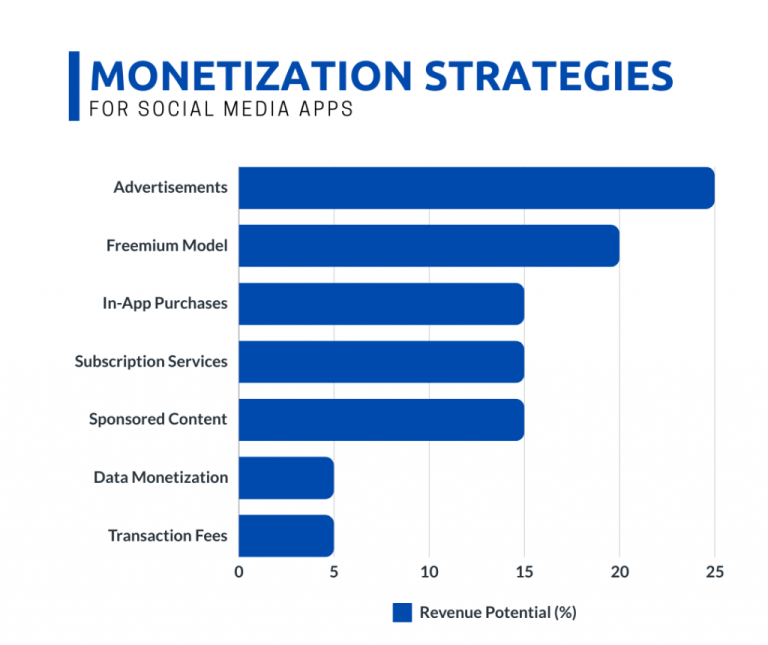
Advertisements
- Incorporate targeted advertising within your app to capitalize on its user base and engagement.
- Display relevant ads based on users’ demographics, interests, and behaviors to maximize ad revenue.
- Utilize formats such as display ads, sponsored content, and native advertising to seamlessly integrate ads into the user experience without being intrusive.
Freemium Model
- Offer a free version of your app with basic features while providing premium features or content behind a paywall.
- Allow users to upgrade to a premium subscription for access to exclusive features, enhanced functionalities, or ad-free experiences.
- This freemium model encourages user engagement while providing a steady stream of subscription revenue.
In-App Purchases
- Enable users to purchase virtual goods, premium content, or digital products within your app.
- Offer enticing in-app purchases such as virtual currency, premium filters, stickers, or exclusive content packs.
- Implement a frictionless purchasing process and provide value-added incentives to encourage users to make in-app purchases, thereby boosting revenue.
Subscription Services
- Introduce subscription-based services or memberships that offer premium access to exclusive content, features, or community privileges.
- Offer tiered subscription plans with varying benefits and pricing options to cater to different user segments.
- Provide incentives such as discounts, early access, or VIP perks to incentivize users to subscribe and retain their memberships.
Sponsored Content and Partnerships
- Collaborate with brands, influencers, or content creators to produce sponsored content or branded campaigns within your app.
- Offer sponsored posts, product placements, or sponsored challenges that align with your app’s audience and content themes.
- Forge strategic partnerships and sponsorships to monetize user-generated content and drive brand engagement and awareness.
Data Monetization
- Leverage user data and insights collected within your app to offer targeted advertising, market research, or analytics services to third-party advertisers or businesses.
- Ensure compliance with privacy regulations and ethical data practices while monetizing user data responsibly.
- Offer anonymized and aggregated data insights to maintain user trust and transparency.
e-Commerce Transaction Fees
- Facilitate transactions or e-commerce activities within your app and charge transaction fees or commissions on purchases made through your platform.
- Offer a secure and seamless payment infrastructure and provide value-added services such as buyer protection, escrow services, or dispute resolution to incentivize users to transact through your app.
By implementing a combination of these monetization strategies, you can effectively generate revenue from your social media app while providing value to your users. Experiment with different approaches, analyze user feedback and behavior and iterate on your monetization strategy to optimize profitability and sustainability in the competitive app market.
Final Note
Creating a social media app is like exploring a world of endless connections, kind of like Facebook or Quora. In today’s digital age, where we’re always online, making a social media app that fits your audience is super important.
To make your dream social media app, you need a great partner, and that’s where Resourcifi comes in. We’re not just tech experts; we’re the builders who can turn your big ideas into real apps, whether it’s for Android or iOS.
We do a bunch of things – from making custom social networks to cool messaging apps and even full-on app development. Our team of experts knows all about making mobile apps, and we’ve helped lots of different businesses with their social media apps.
Now’s your chance to jump into the future! The world of social media app making is calling. Chat with our awesome team of social media app makers, and let’s make the digital world even cooler.



